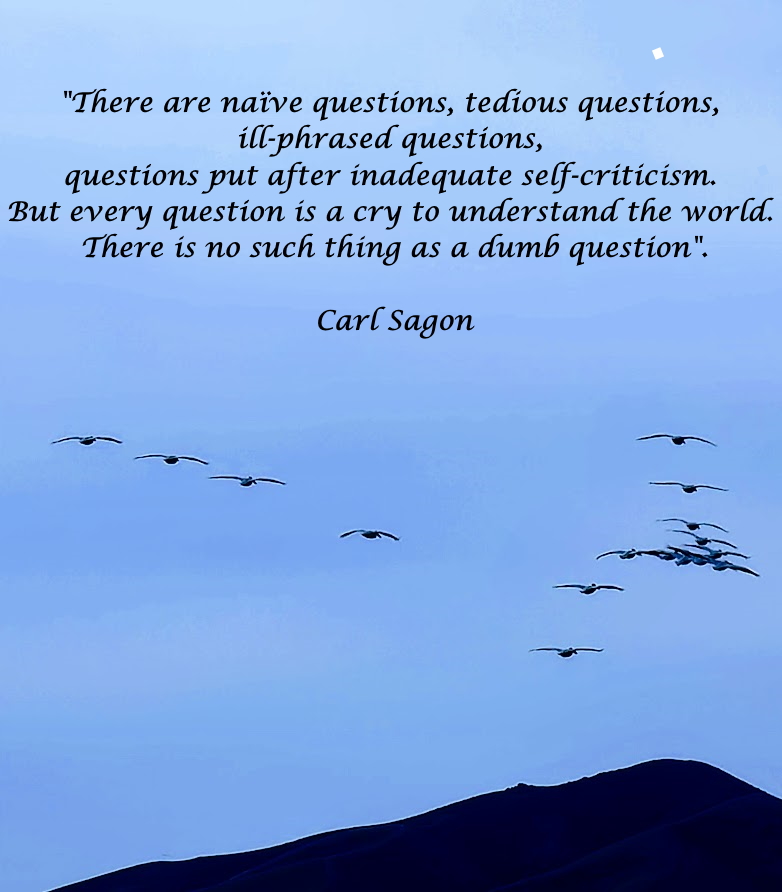
“Is a pelican considered a carnivore”? My fellow pod-caster/wandering companion, Christine, posed this question to me just a few weeks ago.
Christine has a brilliant mind resplendent with curiosity. I really admire this about her.
She works at a local middle school as a student advocate. Students and co-workers alike, have come to realize that if you want an answer to almost anything you can just ask Christine.
How does she know so much, because she asks ALL the questions no matter how out there or mundane they seem.
Is a pelican a carnivore?
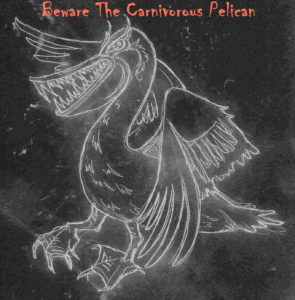
Humorously enough, when the I put that question to my own mind, I immediately pictured a gargantuan pelican with a gaping maw full of dagger like teeth terrorizing the shorelines our local lakes.
This, of course, is an irrational image. Pelican’s don’t eat humans, or things that aren’t found swimming in the water, right?
This seemingly straight forward question, as any good question does, lead to me to ponder further about this remarkable bird: the pelican; In particular the American White Pelican which has so recently made it’s vernal return to Utah Lake.
So we will start back with my image of the terrifying “carnivorous pelican”, hungry for beach bound human flesh. Was there once a pelican ancestor like this?
It turns out, that during the late Triassic to the early Cretaceous period, a pterosaur, C. Hanseni, glided over the arid landscape of Utah, sporting a probable flange or wattle pouch, very similar to a pelican.
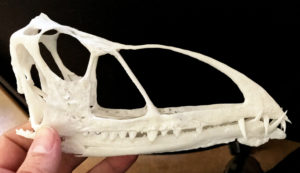
And yes, it did claim a mouth full of teeth. 112 plus four jutting fangs to be exact! And it’s wingspan was quite impressive…for it’s era.
Here is where my people eating version starts to break down.
C. Hanseni ‘s wingspan was about 5 feet – that is about 4 feet shy of the American White Pelican of today. And it probably existed on a diet of insects and small reptiles, not frightened humans or even mammals or their prototypes.
The American White Pelican by contrast can have a wing span of over 9 feet and weighs in at anywhere from 15 – 30 lbs. That makes it the second largest bird in North America next to the California condor! But it still it is not nor ever has been a people eater.
Despite this slight disappointment to my imagination, pelicans do claim an an ancient avian heritage having evolved some 30 million years ago into the modern birds they are today.
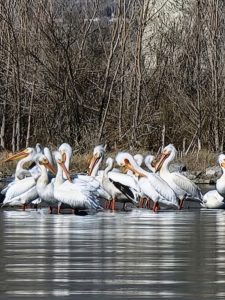
I have met several people in Utah Valley, where I live, who were surprised to learn that “briefs, “pods”, “pouches”, “scoops” and or “squadrons” of pelican, as they can be collectively referred to, inhabit Utah Lake for a season every year. And to be honest, when I first started visiting the lake regularly I,too, was surprised by this.
Having lived by the Oregon coast as a teen and young adult, I primarily associated pelicans with the ocean.
It turns out that, of the two species of pelican that live in North America, only the Brown Pelican is a salty dog. The American White Pelican is considered a fresh water bird, though, here in Utah, it gives a special sort of nod to its briny cousin.
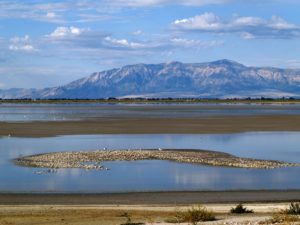
Gunnison Island, a remote piece of real estate off the shores of The Great Salt Lake is home to the third largest White American Pelican nesting colony in North America. 10-20 percent of the total population of American White Pelicans use this isolated island as a rookery.
The Great Salt Lake, however, is devoid of the pelican’s main food source: fish. Hence the birds rise on the thermals each morning flying miles every day to catch dinner. Many of them go to the Bear River Migratory Bird Refuge, but a few take the nearly 100 mile southbound trip to hunt in Utah Lake.
American White Pelicans have a very unique and effective way of feeding. They are fish herders!
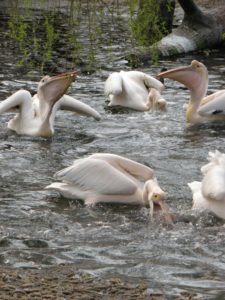 That’s right, these clever birds, will flock together in the water, using coordinated efforts to force schools of fish into the shallows. Once there, the whole group, just dives right in to collect their tasty snacks.
That’s right, these clever birds, will flock together in the water, using coordinated efforts to force schools of fish into the shallows. Once there, the whole group, just dives right in to collect their tasty snacks.
Below is a wonderful audio description I am sharing from the wonderful Utah Public Radio Production: Wild About Utah.
What about those funny looking pouches, you might be asking? Do they store dinner whole, fish bowl style, while jetting it back to hungry chicks?
The answer is no. Although the pelican pouch can hold up to 3 gallons of water, once these birds engulf or “net” their prey, they drain the water out by tipping their heads before swallowing their captives whole.
Chicks are fed by the ever the so appetizing regurgitation method. Yummy! (I am being a bit anthropomorphic and human-centrist here). This method of feeding young, adopted by many avian species, is both practical and highly efficient when considering the distances these parent birds have to travel between nesting sites and hunting grounds.
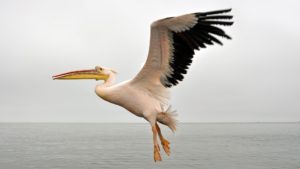 The American White Pelican is impressive in many ways. It is spectacular to observe these pro flyers cruising above the water without flapping a a wing. Resembling some sort of power glider, they can travel this way for quite a distance until at last the wings rotate vertically and webbed feet extend just in time to execute a perfect water landing.
The American White Pelican is impressive in many ways. It is spectacular to observe these pro flyers cruising above the water without flapping a a wing. Resembling some sort of power glider, they can travel this way for quite a distance until at last the wings rotate vertically and webbed feet extend just in time to execute a perfect water landing.
 This cagey bird also secrets a showy surprise, visible only when wings are extended. A neat row of black flight feathers doubles as a dapper trim. Against the American White Penguins nearly ubiquitous snowy plumage, it recalls to my mind the spectator wing tip oxfords that were so popular in the swing era.
This cagey bird also secrets a showy surprise, visible only when wings are extended. A neat row of black flight feathers doubles as a dapper trim. Against the American White Penguins nearly ubiquitous snowy plumage, it recalls to my mind the spectator wing tip oxfords that were so popular in the swing era.
I wonder if the American White Pelican might have inspired the design? If you know the answer to this question, be sure to let me know through leaving a comment.
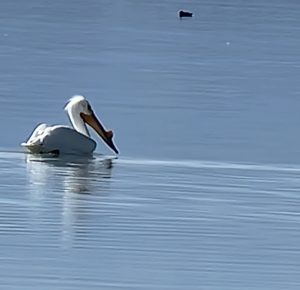
During the early spring, until about May, one might notice a peculiar hump or “horn” as it is often referred to, growing on top of a pelican’s beak. This unique appendage apparently makes an appearance only during the mating season. Occurring on both male and female birds, it simply falls off after young are produced.
Somewhere out on a sandy beach or rocky shoreline, there is a curiosity to be discovered; A pelican horn, kind of like a unicorn horn, only different! Here is a fun and informative blog I enjoyed about this funky feature.
I could go on and on about how interesting these bird peoples are, but that would make this blog quite a tome. And I will leave room for you, dear reader, to investigate further.
Before I end, however, I would like to rewind a bit and revisit Gunnison Island. Although American White Pelican numbers have generally been increasing in the U.S., they are certainly becoming a bird of concern here in Utah. During my research I learned that In 2020 the number of chicks produced on Gunnison island had decreased drastically from what used to be be between 4000 – 5000 chicks per season down to only 500.
Why is this happening?
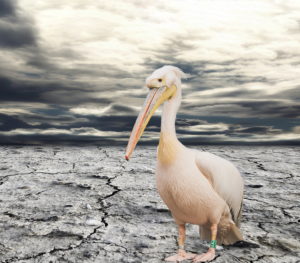 There is no question that drought and climate change are effecting this iconic lake. Yet, the biggest hand in this environmental emergency, it turns out is the largely unbridled interests of big industry and agriculture. Aided and abetted by short sighted politicians, precious fresh water tributaries are continually being diverted away from the lake towards the unchecked demands of a growing urban population.
There is no question that drought and climate change are effecting this iconic lake. Yet, the biggest hand in this environmental emergency, it turns out is the largely unbridled interests of big industry and agriculture. Aided and abetted by short sighted politicians, precious fresh water tributaries are continually being diverted away from the lake towards the unchecked demands of a growing urban population.
To read an excellent article by the Audubon Society about the crisis at the Great Salt Lake and the precarious fate of the American White Pelican be sure to click on the links at the end of this blog.
When I first began this post, I started with the exercise of writing a poem about the American White Pelican. I do not profess to be a great poet, but I love the practice of this art form. My mind (often a bit on the goofy side) could not resist the idea of writing a poem in canticle form – a “Peli-Canticle” if you will.
I hesitated, at first, to share this activity. Yet, despite the slightly silly title, I think this attempt does capture, at least a little, the current struggle that the White Pelican is facing here in Utah.
I hope you will enjoy it, and that it might give you pause to think and maybe ask more questions of your own.
Peli-canticle for the American White Pelican in Utah
The coyote knows a thing or two – like Moses
Coyote knows to sally forth at the parting of the sea
In this case the Great Salt Lake has birthed a briny passage
Gunnison Island, no more but aye, land! Ironic coyote laughs – poor
Pelican, it’s pallid rookery, brief colony of (once) isolated egg and young
The idyll of this Eden (as with all Edens) fate will not endure
In the sweating city, eternal fountains flow towards thirsty lawns who drink up and yawn,
It is a slow asteroid, for the modern pterasaur, in dryness raining down
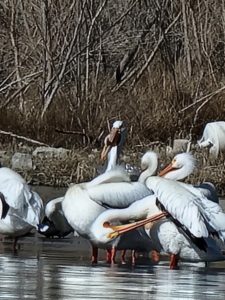
Oh yeah! I almost forgot to answer the question posed at the beginning of this blog.
Of course pelicans are considered carnivores, mostly of the pescatarian kind – meaning fish eater. However, American White Pelicans have *also been known to eat a craw fish, turtle, an occasional duck or pigeon and yes, even small mammals! Who knew? I didn’t…
Questioning is the minds way of wandering. It is the blooming of awareness that brings us closer to understanding this beautiful world and our relationship with and to it.
Happy Wandering…
Click HERE to read the Audubon article about the Great Salt Lake.
Click HERE to read further about the 2020 decline at the Pelican rookery on Gunnison Island
